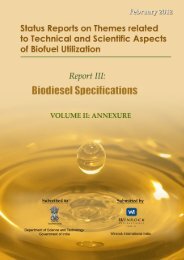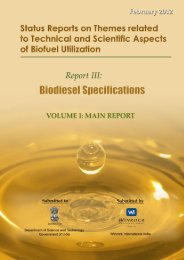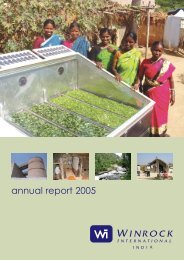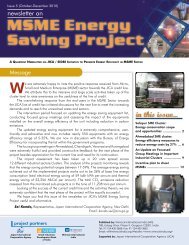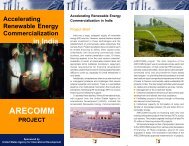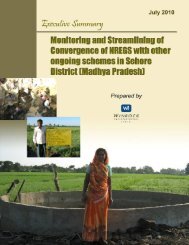IssuE 8 â ApRIl â JuNE 2011 - Winrock International India
IssuE 8 â ApRIl â JuNE 2011 - Winrock International India
IssuE 8 â ApRIl â JuNE 2011 - Winrock International India
You also want an ePaper? Increase the reach of your titles
YUMPU automatically turns print PDFs into web optimized ePapers that Google loves.
Energy from Bamboo<br />
Low Cost Biomass from Captive<br />
Energy Plantation<br />
The demand for renewable<br />
energy through biomass is<br />
increasing, but the utilizable<br />
biomass is not available sufficiently.<br />
The present agricultural waste<br />
available in cotton field as stalk,<br />
maize field as stalk and corn, paddy<br />
field as straw and husk, sunflower<br />
field as stalk & head are suitable for<br />
biomass, but the collection becomes<br />
very laborious. To generate 1 MW of<br />
electricity, the requirement of biomass<br />
varies from 8,000 to 10,000 tons every<br />
year, which is available from 6,000 to<br />
8,000 acres of agricultural waste. The<br />
cultivated biomass such as Eucalyptus,<br />
Casuarina and wild Prosophis juliflora<br />
are better substitute for agricultural<br />
waste since the annual quantity of<br />
biomass required for 1 MW is available<br />
from 1,000 to 1,200 acres. The latest<br />
development in bamboo based<br />
energy plantation has resulted in high<br />
biomass, reducing the area required<br />
for 1MW to 200 acres of cultivated hiyielding<br />
clone of bamboo.<br />
BEEMA Bamboo<br />
Biomass from bamboo is considered<br />
best among other known biomass<br />
resources due to its good calorific<br />
value (4,000 kcal/Kg), low ash content<br />
of 0.5% and sustainable harvest.<br />
The usage of bamboo is known for<br />
construction work, furniture, fiber<br />
and paper but for energy as biomass<br />
remains untapped. The new bamboo<br />
variety called “BEEMA” has got<br />
huge potential to bring revolution<br />
as bioenergy resources and it is not<br />
popular among many since it is<br />
something naturally existing with very<br />
low annual yield. The bamboo is the<br />
tallest grass and a non-woody plant,<br />
but still is called a tree. Beema bamboo<br />
is improved clone selected from<br />
naturally occurring wild population of<br />
Bambusa balcooa with specific emphasis<br />
on higher biomass production, better<br />
carbon sequestration, low ash content<br />
and superior fuel quality. It is 100%<br />
homogenous and highly suitable for<br />
high density plantation. and responds<br />
well to agronomic practices.<br />
Beema bamboo is a high density<br />
bamboo which is sterile, fast growing,<br />
thorn less, thick walled and high<br />
yielding. The wall thickness of Beema<br />
bamboo is 3 to 4 times better than other<br />
bamboo species available in wild. The<br />
total dry matter production of Beema<br />
bamboo under optimum condition<br />
ranges from 40 to 50 ton per acre<br />
per year worked with 12% moisture<br />
condition. Beema bamboo has got<br />
calorific value of 4,000 kcal per Kg and<br />
very low ash content of < 1% and is best<br />
suited for energy plantation.<br />
At the same time the total carbon<br />
accumulation every year is from 20<br />
to 24 tons per acre per year which<br />
is equivalent to 73 to 88 ton of CO 2<br />
.<br />
Beema bamboo generates 70 to 80<br />
Certified Emission Reduction (CER)<br />
per acre per year, which is equivalent<br />
to 175 to 200 CER per hectare per year.<br />
Carbon credit can also be obtained<br />
by generating electricity from the<br />
renewable biomass of bamboo. Apart<br />
from providing carbon credit directly<br />
from power generation, the process<br />
of Pyrolysis generates carbon as<br />
byproduct. When this is applied to soil<br />
as soil amendments, it is also eligible<br />
for carbon credit.<br />
As bioenergy resources, bamboo can<br />
meet both thermal as well as electrical<br />
energy requirement and thereby<br />
bamboo can give energy security<br />
in the most efficient way possible.<br />
Energy plantation based on bamboo<br />
could be raised in many parts of <strong>India</strong><br />
April-June <strong>2011</strong><br />
9




